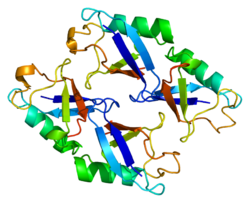Nedd8
Nedd8 (engl. neural-precursor-cell-expressed developmentally down-regulated 8 ‚neurale Vorläuferzelle-exprimiert und in der Entwicklung herunterreguliert 8‘) ist ein Protein. Es wird im Zuge der Neddylierung (für die Nedd8 namensgebend ist) als posttranslationale Modifikation an andere Proteine angehängt. Dadurch werden verschiedene Vorgänge in einer Zelle gesteuert. In der Bäckerhefe (Saccharomyces cerevisiae) heißt Nedd8 (genauer: sein Homolog) Rub1.
| Nedd8 | ||
|---|---|---|

| ||
| PDB 1NDD | ||
| Eigenschaften des menschlichen Proteins | ||
| Masse/Länge Primärstruktur | 81 Aminosäuren, 9.072 Da | |
| Bezeichner | ||
| Externe IDs | ||
| Vorkommen | ||
| Homologie-Familie | Hovergen | |
| Orthologe | ||
| Mensch | Bäckerhefe | |
| Entrez | 4738 | 851717 |
| Ensembl | ENSG00000129559 | |
| UniProt | Q15843 | Q03919 |
| Refseq (mRNA) | NM_006156.3 | NM_001180446.3 |
| Refseq (Protein) | NP_006147.1 | NP_010423.4 |
| Genlocus | ||
| PubMed-Suche | 4738 | 851717
|
Eigenschaften
BearbeitenNedd8 ist ein Ubiquitin-artiges Protein, das am Zellzyklus und an der Embryogenese beteiligt ist.[1] Die Neddylierung ist an verschiedenen zellulären Vorgängen beteiligt, z. B. an der Regulation des Ubiquitin-Proteasom-Systems,[2] an der Transkription,[2] an Zellkontakten[2] und an der global genome repair/nucleotide excision repair-Variante[3] und dem non-homologous end joining der DNA-Reparatur.[4]
Nedd8 wird durch eine Ubiquitin-ähnliche Enzymkaskade kovalent an andere Proteine angehängt.[1] Das entsprechende E1-Enzym ist UBE1C-APPBP1, das E2-Enzym ist UBE2M.[1] Humanes NEDD8 ist zu 60 % identisch zu Ubiquitin in der Aminosäuresequenz. Die hauptsächlichen Ziel-Proteine sind die Culline, die eine Protein-Untereinheit der Cullin-abhängigen E3-Ubiquitin-Protein-Ligasen (engl. cullin-RING ubiquitin ligases, CRL) sind. Die Neddylierung erfolgt über eine Isopeptidbindung an der Carboxygruppe des C-terminalen Glycins von Nedd8 an die ε-Aminogruppe eines Lysins im Zielprotein.[5] Die Bindung von NEDD8 an Culline führt zu einer Aktivierung der E3-Ubiquitin-Protein-Ligase-Funktion und zu einer Ubiquitinierung Ziel-Protein.[1] Das markierte Protein (beispielsweise Cycline) wird dem Ubiquitin-Proteasom-System zugeführt und abgebaut.[1] Nedd8 ist acetyliert.[1] Das Chemotherapeutikum MLN4924 (synonym Pevonedistat) ist ein Inhibitor der Bindung von Nedd8 an Culline.[4][6] Die Proteasen UCHL1, UCHL3 und USP21 können sowohl NEDD8 als auch Ubiquitin abspalten. Das COP9-Signalosom kann spezifisch Nedd8 von der Cullin-1-Untereinheit von SCF-Ubiquitinligasen und NEDP1 (synonym DEN1, SENP8) abspalten.
Eine fehlerhafte Neddylierung ist unter anderem an Krebs, neurodegenerativen Erkrankungen und Herzerkrankungen beteiligt.[2][7]
Einzelnachweise
Bearbeiten- ↑ a b c d e f NEDD8 - NEDD8 precursor - Homo sapiens (Human) - NEDD8 gene & protein. In: uniprot.org. 13. Februar 2019, abgerufen am 12. März 2019 (englisch).
- ↑ a b c d S. Kandala, I. M. Kim, H. Su: Neddylation and deneddylation in cardiac biology. In: American journal of cardiovascular disease. Band 4, Nummer 4, 2014, S. 140–158, PMID 25628956, PMC 4299693 (freier Volltext).
- ↑ R. Groisman, J. Polanowska, I. Kuraoka, J. Sawada, M. Saijo, R. Drapkin, A. F. Kisselev, K. Tanaka, Y. Nakatani: The ubiquitin ligase activity in the DDB2 and CSA complexes is differentially regulated by the COP9 signalosome in response to DNA damage. In: Cell. Band 113, Nummer 3, Mai 2003, S. 357–367, PMID 12732143.
- ↑ a b J. S. Brown, N. Lukashchuk, M. Sczaniecka-Clift, S. Britton, C. le Sage, P. Calsou, P. Beli, Y. Galanty, S. P. Jackson: Neddylation promotes ubiquitylation and release of Ku from DNA-damage sites. In: Cell Reports. Band 11, Nummer 5, Mai 2015, S. 704–714, doi:10.1016/j.celrep.2015.03.058, PMID 25921528, PMC 4431666 (freier Volltext).
- ↑ Z. Q. Pan, A. Kentsis, D. C. Dias, K. Yamoah, K. Wu: Nedd8 on cullin: building an expressway to protein destruction. In: Oncogene. Band 23, Nummer 11, März 2004, S. 1985–1997, doi:10.1038/sj.onc.1207414, PMID 15021886.
- ↑ N. M. Czuczman, M. J. Barth, J. Gu, V. Neppalli, C. Mavis, S. E. Frys, Q. Hu, S. Liu, P. Klener, P. Vockova, M. S. Czuczman, F. J. Hernandez-Ilizaliturri: Pevonedistat, a NEDD8-activating enzyme inhibitor, is active in mantle cell lymphoma and enhances rituximab activity in vivo. In: Blood. Band 127, Nummer 9, März 2016, S. 1128–1137, doi:10.1182/blood-2015-04-640920, PMID 26675347, PMC 4778163 (freier Volltext).
- ↑ Y. Chen, R. L. Neve, H. Liu: Neddylation dysfunction in Alzheimer's disease. In: Journal of cellular and molecular medicine. Band 16, Nummer 11, November 2012, S. 2583–2591, doi:10.1111/j.1582-4934.2012.01604.x, PMID 22805479, PMC 3484225 (freier Volltext).